Life on the Farm Part III Guest Blogger–Jack Costello
This is the last in a three part series written by Norman’s Uncle Jack about life on the Costello farm around 1920. The first two parts can be found here and here. Again, the words are Uncle Jack’s, I have added some pictures.

Convenience was not to be associated with the family wash. The transition from scrub board to the washing machine marked the advent of the use of small engines to power appliances.
The internal combustion engine on the washing machine made lots of blue smoke, and, with the carbon monoxide, had to exhaust outside. Moved to an outbuilding, the function required another kitchen range to heat the water. The powered mechanism moved an agitator in the center of the machine, but each article had to be put through two rinses after leaving the machine. It all went through the wringer three times, and that wringer was hand operated. Since cloth will freeze dry, the winter wash was occasionally hung out. Wet weather, however, meant trying to find room inside on folding, collapsible clothes racks.
Power was also required to pump water, chop feed, and generate electricity. This stationary power plant was a primitive, gasoline powered, combustible engine, commonly known as a “one lunger”. Appropriately named because it had only one piston. It was inordinately large by modern standards. The combustion chamber was about the only part that was not exposed. While fascinating to watch, it was inefficient in operation. The “V” belt had not been developed; the one lunger moved the load with flat belts and these were often a source of trouble. Overall, things were better with than without.
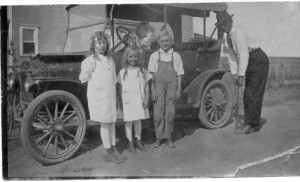
The Model T Ford was the family car at this time. The first Ford was purchased around 1918. Like all else on a farm, the family car was used mainly for necessities, for carrying the family to church on Sunday, and for emergency runs into town for machine parts or provisions. The first family automobile was not a Ford, but a Stanley Steamer. Operating one reputedly required more plumbing skills than mechanical. Eventually the Stanley failed and was replaced by the Ford Model T. The successful farmer, always resourceful, usually kept a supply of gasoline on hand in 5-gallon cans (no AAA to call on in those days). That reserve enabled a driver to “tank up” before heading for town.
Another reserve that was standard practice was keeping a supply of flour on hand for baking (bread was made four loaves at a time). The town of Sprague, like many communities, had a small flour mill. Wheat grown locally, especially Turkey Red, made an all-purpose flour, so the farmer saved a little and used his own. Flour was stored in 50-pound sacks, 6 to 8 at a time, upstairs on a landing near the bedrooms.
Before the consolidation of country school districts, the country school was a significant factor in the lives of farm families. The district hired its teacher from Cheney Normal, and arranged for housing for her with one of the families. Textbooks and curriculum and an occasional visit came from the County Superintendent.
The school building, a one-room frame, with anteroom in front for boots, coats and lunch boxes, was heated by a big wood stove. Most teachers were young. One 18-year old resigned after a few months because her “nerves were all unstrung”. Her successor was a more resilient 19-year old who enjoyed outdoor games even when rules were altered to her disadvantage. Teachers were thought to favor the children of families with whom they boarded so that was a cause of some friction. The “student body”, always small, was at one time in the 20’s all Costello cousins. For high school, students had to travel into Sprague.
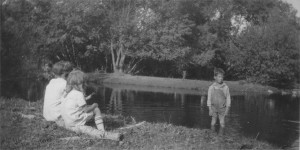
Although farm families were notably hard working, there was some time for recreation. Summer picnics were big events, most notably on the 4th of July, at Sprague Lake. And family feasts of fried chicken, corn on the cob, and homemade ice cream, were memorable. On days off, Crab Creek was close enough for a car full of swimmers (in make-do swimwear).
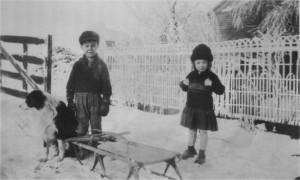
In winter, despite the hardships of the cold, children had their compensation in sledding, and occasionally a large section of the yard was flooded to form a pond for ice skating.
Regardless of the time of year, water was critical to the farm operation. With all of those horses, the farmer that had insufficient water, especially at harvest, was in deep trouble. Money spent to increase well depth was good insurance. The windmill sat over a well casing that penetrated over 100 feet, and through a rather clever valve arrangement, sent water either to a faucet open at the time or to a cistern for storage.
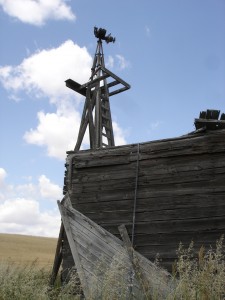
The cistern was located on a hillside at an elevation well above anything in the house or farmstead so if the windmill was shut off, water came from the cistern and was gravity fed. Rather infrequently the wind failed to develop sufficient force to turn the big fan and pump. The the “one lunger” was called upon. With a device called the “pump jack”, clean cool water was sent to the open faucet.
Hot water for the house was provided through a system of coils in front of the kitchen range. Because no other heat for cooking was available, the cookstove was used daily, and the hot water circulated to a nearby galvanized storage tank. This system worked, but provided a limited quantity, enough for dishes, and perhaps a couple of baths. The family wash required a topside boiler, a copper lined job of 20 to 30 gallon capacity, sitting directly over the flames. The electric hot water tank did not arrive on the farm until the mid 40’s.
Construction of the cistern has to be one of the truly clever undertaking of that time. Reputed to have a capacity of 13,000 gallons, from the inside it appeared to be a concrete bottle with its lower 90% below the earth’s surface. Bottom and walls were concrete grout and mortar trowelled to a firm earthen surface. This thing was a hand dug hole with symmetry that approached an art form. Everything above ground was bricked up, with a 3-foot opening at the top, covered by a piece of sheet metal. Native grasses and weeds hid everything but the very top of the cistern and the overflow pipe. Another thing hidden was the fact that covering the cistern with sheet metal, with weights to keep it tight, did not prevent field mice from squeezing in and dropping to their doom, settling at the bottom, below the outlet. Now, while the water had qualities that made for strong teeth, those drop in visitors weren’t exactly an amenity. The horses never complained, but for the farmer, cleaning the cistern was a chore with some rewards.
Critical to the farming operation was the prudent marketing of crops. With only one payday per year, the successful operator combined all of his skill with perhaps some good fortune to net a profitable return for the year’s effort.
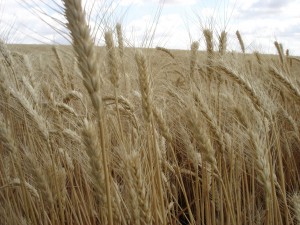
He was assessed a handling charge immediately upon delivery, and from there on a month storage charge. Quotes would be available from several grain dealers at different destinations, sometimes involving a knowledge of freight rates. Market volatility and poor relations with grain dealers, who often profited handsomely at the farmer’s expense, eventually resulted in the formation of cooperatives. These co-ops did not completely remove the need for competent marketing but the atmosphere was made more friendly. Modern farm operators have computers and ready access to market information and also the advantage of governmental regulations limiting price changes. While there is still some wailing and gnashing of teeth, marketing has become easier.
The era ends! Following a typical auction of stock and equipment, the family moved to Spokane in September 1928. Due to health problems, John T. quit farming at age 55. Despite his disappointment with this early end to his farming career, the timing was somewhat fortuitous because the Great Depression was only a year removed. And that’s another story.
In the subsequent decade, wheat farming underwent drastic changes. Tractors replaced horses and, with the advent of farm trucks, harvested wheat no longer had to be sacked. The new method, called bulking, eliminated the highest paid member of the harvest crew, the sack sewer. And the young man who jerked the top of the sack to insure a filled sack, the jigger, was no longer needed. While bulking was progress, the less progressive cited commingling of grains in the co-op elevator as unrewarding to the quality producer. Grading by the State Department of Agriculture solved the problem.
Further progress came when electricity became available. A federal agency, the Rural Electrification Administration, made low interest loans for their service. Later, to, come indoor plumbing!
This brief account of farming in general and the Costello farm specifically, does not pretend to be a literary effort nor an exhaustive compilation of facts. It is presented, however, in the hope that it will help our posterity appreciate the challenge of early times in the wheat country of Eastern Washington, especially as experienced by John T, Elizabeth, et al.
John A. Costello
June 1992

Leave a Reply